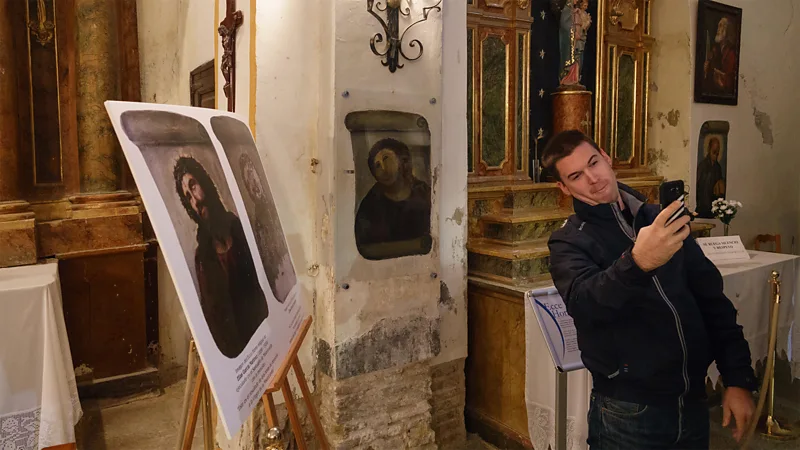What makes a tourist attraction?
As travellers increasingly follow social media feeds and internet memes, the most unlikely of things can become tourist attractions.

The docent said she wanted to take our photo. "To send it to Cecelia in order to let her know what a good thing she did," said the woman. "That people are now coming to this small town in Spain because of her 'mistake'."
I was in Borja, a 5,000-person town in Spain's northern Aragon province. It was here that in 2012, an elderly parishioner and amateur art restorer named Cecilia Giménez captured the world's attention when she chose to touch up a fresco of Jesus Christ titled Ecce Homo in the Santuario de Misericordia church that had deteriorated since it was painted in the 1930s. Giménez had originally proposed to just add some colouring to Jesus' clothing. But as the 81-year-old was working on it, she couldn't help herself: she began repainting the face.
When she took a break from her duties to go on holiday, she returned to find crowds of shocked people and a horde of international press at the church. The restoration looked so different that local authorities initially assumed the painting had been vandalised. Yet, it was just the (unfinished) work of Giménez, who thought she could restore the painting to its former glory.
Instead, Ecce Homo ("Behold the Man" in Latin) was rebranded "Ecce Mono" ("Behold the Monkey") by the Spanish media. At first this seemed like an art tragedy. The image of the "Monkey Christ", as the English-language press deemed it, was all over the internet. Memes were created. Social media mocked it to death. And Giménez became a hermit in her home, stricken with grief from all the ridicule it caused.
But then something interesting happened: tourists started turning up in Borja. This small town that had previously welcomed just 5,000 visitors per year suddenly had a surge of travellers coming to see the botched restoration of Ecce Homo. Today, officials say that between 15,000 and 20,000 tourists per year flock to Borja to see the famous flub of a portrait, which is now, like the Mona Lisa and other masterpieces of the art world, behind a protective shield of glass.
On a recent trip with my Spanish-born wife to visit her family in the nearby city of Zaragoza, I suggested we take a daytrip to Borja to see the simian saviour. My sister-and-law and her daughter looked at me for a moment before one of them uttered, "Why would you want to see that?"
Ever since I saw the post-restoration image of Ecce Homo, I was fascinated by it. I couldn't explain why, but I wanted to see it with my own eyes. Like so many seemingly random things these days, it had become an unlikely tourist attraction.
In his book The Tourist: A New Theory of the Leisure Class, sociologist Dean MacCannell writes: "anything is potentially a [tourist] attraction. It simply awaits one person to take the trouble to point out to another something noteworthy or worth seeing … Sometimes we have official guides and travelogues to assist us in this pointing." But more and more often, social media feeds now serve as our travel guides, pointing tourists towards things like unassuming rural villages, quirky roadside attractions and far-flung art installations.
In fact, the story of the Ecce Homo is a perfect example of what MacCannell believes motivates many modern travellers to get on a plane or train in the first place: "All tourists embody a quest for authenticity," he writes.
In a way, the botched Ecce Homo is as authentic as it gets: a genuine, real thing born from a mistake. And as I was about to find out, that's part of the painting's appeal.
An hour and 70km after leaving Zaragoza, we were in the sleepy, medieval centre of Borja. The Santuario de Misericordia is located roughly 5km away and up a hill from town's central plaza. After paying a €3 entrance fee, the docent led us into the chapel and there it was: the "Monkey Christ". As we lingered, a dozen or so other tourists arrived to see the monkey messiah.
"MoMA in New York was interested in purchasing it at one time," the docent told us. "But it would have caused too much structural damage to move it from the building."
Giménez "was devastated by the response to her 'mistake'," the docent added, using air quotes with her hands. "And that's why we've been trying to convince her that she has actually done a very positive thing for the community. She put Borja on the tourist map." She then pointed to a map of the world tacked to the wall. Hundreds of pins were stuck into spots on the globe where visitors have come from to see Ecce Homo. There were so many over North America, Europe, and Japan that you could no longer see country outlines, just the pin heads. In all, visitors from 110 countries have now come to see it.
With Ecce Homo now behind glass and a gift shop at the exit, the church in Borja has a staged, ready-for-tourism aspect to it. As we walked toward the exit, we passed through a gift shop selling Ecce Homo-branded coffee mugs, mousepads, keychains, tote bags, wine bottles and T-shirts. There was a machine making a bronze coin with the image of the so-called Monkey Christ. In an adjacent room, an "Interpretation Centre" displayed works of art inspired by Giménez's restoration, including a photo of someone dressed in an Ecce Homo costume for Halloween and several paintings attempting to recreate the scene of Giménez restoring the fresco.
There was even a photo stand-in, in which you can put your face in the hole and have a photo of yourself as Ecce Homo. My wife (then girlfriend), Ivana, and I both did it and used the photo as part of our wedding invitation a year later.
When I asked MacCannel why he thought the Ecce Homo had become a tourist attraction, he had a unique take on it, saying that the original artwork, when it was in pristine condition, had previously garnered almost zero attention. "The pre-botched fresco was understandably not a reason for tourists to visit the church – probably not much a component of the motivation of the devout to visit."
But by commodifying Ecce Homo and turning this uniquely botched restoration into just another tourist attraction with entrance fees, crowds and selfie-posing visitors, I couldn't help but wonder whether the powers that be in Borja risked squandering the unique appeal and authenticity of the painting itself – the very reason that led me to visit it in the first place. Perhaps that was inevitable, and as I would soon learn, this has had a few positive effects too.
Since the church began charging visitors a €3 entrance fee and selling souvenirs in 2016, the proceeds have funded new jobs at the church (such as the docent's) and a large portion is donated to the retirement home where Giménez now lives.
A few other unexpected things have happened since the painting became a tourist attraction, including an increased interest in Giménez's artwork. Shortly after the revelations of the botched Ecce Homo, one of her own paintings sold at a charity auction for $1,400.
According to one article in the Spanish press, for the last few years, Ecce Homo-inspired tourism, image rights and programmes generated €45,000 in 2021 alone for the town of Borja. There's even been an opera written about Giménez and Ecce Homo that premiered in the United States in autumn 2023. When it was performed in Borja a few years earlier, Giménez was in attendance. She loved it.
After leaving the church, we ate lunch at a restaurant in the centre of Borja. Over creamy jamon croquetas (ham croquettes), fried artichokes and glasses of local Garnacha wine – previously the only thing Borja was well-known for – my previously sceptical sister-in-law, Pilar, and her daughter, Ara, made a surprise announcement: they liked our trip to Borja.
"I didn't understand why you wanted to see this," Pilar said. "But after hearing about the life of Cecilia and seeing the painting with my own eyes, plus learning about all the people from around the world who want to come here, I totally get it now."
As Francisco Miguel Arilla, the former mayor of Borja, said to the press: "In the end, time puts everything in its place."
-BBC







